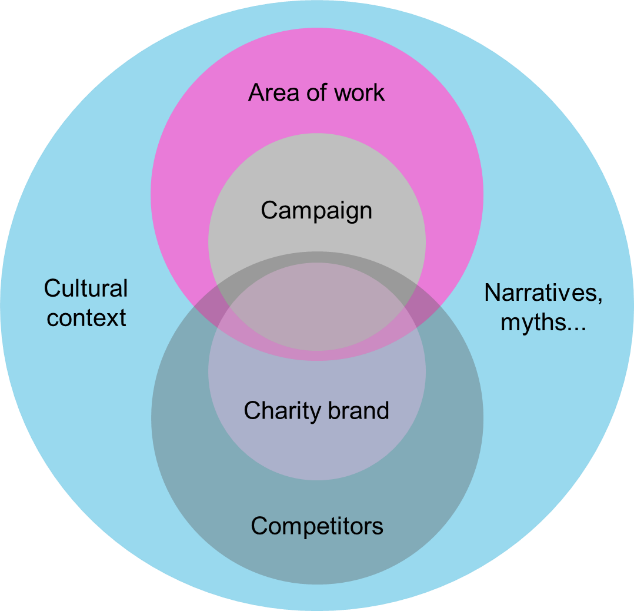Why do people donate to charities? Why do they dedicate their time to volunteering? The crude answer is that they want to do good. The more nuanced answer is that charities are powerful sources of meaning for those who engage with them.
People are always on the lookout for meaning – in the jobs they do, in the clothes they wear, in the food they eat. They need stuff to be meaningful. And their engagement with charities is no exception. Charities are not just institutions – they are cultural artefacts loaded with values, associations and stories. Their ability to attract supporters and get their messages across depends on their ability to create meaningful experiences for their audiences. In order to do so, they need to understand how meanings work. In other words, they need to be good semioticians.
Semiotics is the study of signs and symbols. A ‘sign’ should be understood as pretty much anything which represents something else. Cars, diamonds, baseball caps, cups of tea and charities are all signs because they mean something to the people who engage with them. Semiotics studies how and why this happens. Charities that seek to play a meaningful role in people’s lives can therefore benefit a lot from its insights.
No sign is an island
One of the key insights of modern semiotics is that no sign exists in isolation. Think of meanings like colours. Something can only look red when it is viewed against the right background of other colours. Similarly, something can have a given meaning when viewed within the right cultural context. For example: a V-sign made of two raised fingers can mean peace, victory, an insult or the number 2, depending on the cultural context in which it is used.
Charity logos are a good example of this ‘cultural embeddedness’ of signs. Consider the following two logos of the National Autistic Society from 1963 and 2018. The old logo on the left relies on the then-common metaphor of autism as a puzzle. The puzzle sign, of course, is derived from a popular game of jigsaw puzzle that was invented in England in the 18th century. It has come to be associated with a mystery, or something that doesn’t quite ‘fit in’.

In contrast, the 2018 logo draws upon the most common metaphor for autism today: a spectrum. The idea of a spectrum is derived from 17th century physics where it referred to a band of colours formed from a beam of light. It has gradually come to denote any continuous range of things, and has been used in the discourse on autism since the late 1990s. The current logo would have been completely unintelligible a few decades ago. Equally, the old logo is hardly comprehensible today. For someone outside of the western context, neither logo would have much meaning.
For charities to connect with the public, their messages must be meaningful and culturally consistent. For instance, imagine you run a campaign to raise awareness of the fact that people with autism face difficulties at work. You’ll presumably want your campaign to be informed by the signs that our culture uses to talk about autism, such as the ones outlined above. However, you’ll also need to draw broader signs that our culture uses to signify work environment, conflict and other things. Your campaign should also make sense within your brand context.

How to be an angry teenager
The first semiotic task every charity faces is how to establish a brand. A charity brand is nothing but a pile of signs and symbols that interact with the rest of culture. Each brand has a unique persona, a unique voice and a unique “language” in which it communicates.
Charities are usually rooted in cultural ideologies, otherwise known as ‘myths’. A myth is a powerful, universally accepted story that is implicit in the way we communicate. Think of a charity like the Royal British Legion, which provides supports for military veterans. Much of its fundraising success comes from the broad appeal of deeply engrained stories like the British victory in the ‘Great War’, the historical role of the British nation and the famous poppy fields. These stories are the main sources of brand meaning in the public consciousness. Without knowing these stories, you will never quite understand what the Royal British Legion stands for.
But brands are also linked to their competitors. Like many cultural constructs, charities acquire their unique identity through differentiation from other charities. Just like you cannot understand masculinity without understanding femininity, you cannot understand the Greenpeace brand without knowing about other environmental charities, like the WWF. One environmental consultant compared the difference between Greenpeace and the WWF to the difference between “an angry teenager and an elegant, silvery 50-year-old”. This is indeed how they are often perceived. However, their identities would be much weaker if they didn’t have each other.

What this means is that to build a unique brand identity, charities need to be aware of the entire charity landscape. They need to understand how the landscape is structured and find their own unique place within it.
Can dolls save the Arctic?
One might object that charities don’t need to study culture – the point is to change it. That is true. However, you can only achieve cultural change if you have the right semiotic resources at hand. When charities run campaigns, they are essentially trying to regroup symbols and disrupt myths. To do so, they need to know how these myths operate and acquire the techniques to challenge them.
There are different techniques that charities can use to disrupt meaning. Some semioticians distinguish between two primary ways of shifting meaning – metaphor and metonymy. In metaphors, we use signs to refer to things that share certain structural similarities with their usual referents. Metaphors are often imaginative and emotional. For instance, British Heart Foundation used the image of a cigarette to talk about blood vessels to draw attention to how these vessels become clogged, which helped them achieve a deep, visceral response from the reader.
In contrast, metonymy is more down-to-earth as it uses a sign to refer to something which is closely associated with its usual meaning. For instance, Mothers’ Union used the image of crayons as a metonym for childhood to illustrate the impact of commercialisation on children.
The following campaign by Greenpeace to save the Russian Arctic shows how the two tropes can be combined. The Russian doll functions simultaneously as a metaphor and a metonym. It is a metonym for Russia as its country of origin. On the other hand, it is a metaphor for the decline of the arctic, as its diminishing size reminds you of a melting glacier. While the metonym draws attention to the location of the problem, the metaphor communicates its urgency.
While semiotics has been used in commercial marketing for decades, its usefulness for charities is an underexplored territory. Great use of signs, images, and an understanding of culture are at the heart of many of the best brands. To engage with the public and challenge cultural perceptions, charities need to be culturally smart and embrace the semiotic way of thinking to its fullest.

